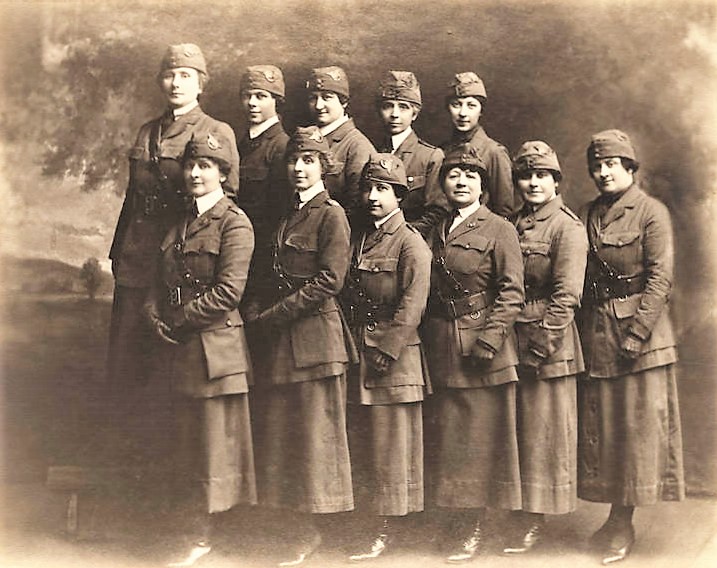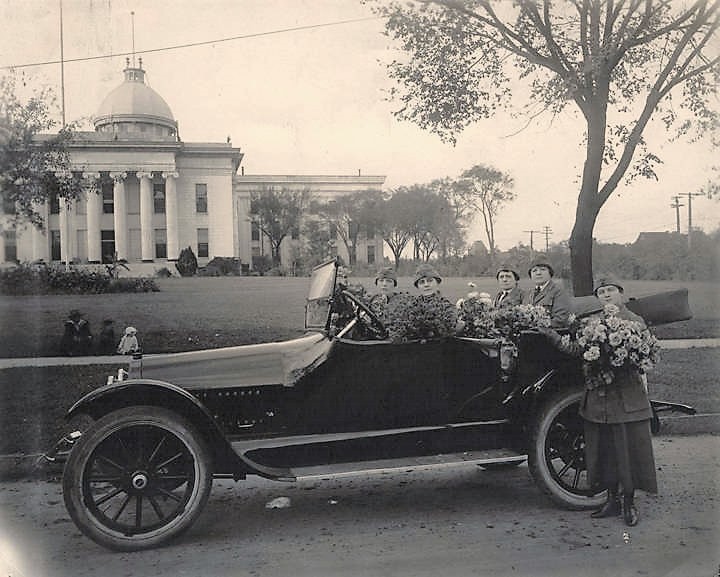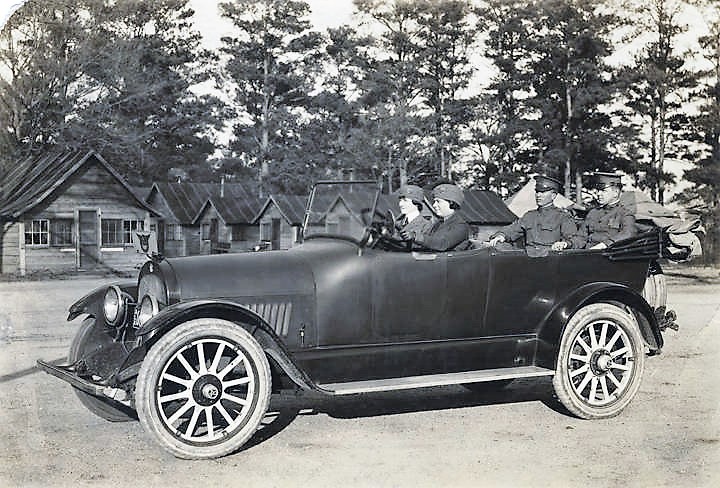THE MONTGOMERY MOTOR CORPS
The Montgomery motor corps was a department of the National League for Woman’s Service, organized by Mrs. William J. Hannah, Chairman of the League for Montgomery County, April 25, 1918. The plan of organization of the New York Motor Corps of the league was used, as well as the uniform and motor car insignia.
 Staff of the Montgomery Motor Corps of the National League for Women’s Service. ca. 1918 Left ot right on the lower row “Captain, Mrs. Fred S. Ball; Adjutant, Miss Anna S. Ball; Lieut., Mrs. Gaston Greil; Lietu., Mrs. Leopole Strauss; Lieut., Mrs. W. H. LeGrand; Lieut., Mrs. John A. Flowers. Left to right on the top row; “Mrs. W. J. Hannah, local chairman; Serg., Mrs. Sidney Winter; treasurer; Lietu., Mrs. Mose Scheur; Lieut., Mrs. Ellis Burnett; Lieut. Mrs. J. M. Nicrosi.”(Alabama Department of Archives and History)
Staff of the Montgomery Motor Corps of the National League for Women’s Service. ca. 1918 Left ot right on the lower row “Captain, Mrs. Fred S. Ball; Adjutant, Miss Anna S. Ball; Lieut., Mrs. Gaston Greil; Lietu., Mrs. Leopole Strauss; Lieut., Mrs. W. H. LeGrand; Lieut., Mrs. John A. Flowers. Left to right on the top row; “Mrs. W. J. Hannah, local chairman; Serg., Mrs. Sidney Winter; treasurer; Lietu., Mrs. Mose Scheur; Lieut., Mrs. Ellis Burnett; Lieut. Mrs. J. M. Nicrosi.”(Alabama Department of Archives and History)
Ready to respond to emergency calls
The purpose of the organization was to have a body of expert motor car drivers ready to respond to emergency calls and to meet current calls for war time service. A down town headquarters was secured and a lieutenant of the Corps, placed in charge each day, assisted by sergeants, corporals and other members. The Corps was divided into six groups, each serving on a specified day of the week. A seventh group, under a lieutenant, was at the command of Red Cross calls. “Camp Sheridan,” located three miles from the city of Montgomery afforded a field for regular activities.
Car rides for convalescent soldiers
Recreational motor car rides for convalescent soldiers at the base hospital Tuesday and Thursday afternoons of each week were given and thousands of boys were helped to recovery during the year of actual service. During the influenza epidemic the Corps suspended pleasure drives and gave its services to meeting trains, bringing relatives and friends to the bedside of ill and dying soldiers, and affording every possible comfort through that period of distress. Cross country trips of 60 miles were made carrying supplies and Christmas cartons and to carry relatives to sick soldiers.
Flowers for individuals at the hospital
Flowers given by Rosemont Gardens and individuals were carried to the hospital and distributed by the Motor Corps. It purchased gifts and assisted in making Christmas cheer for the 500 boys in the base hospital. The Corps rendered valuable assistance to the U. S. Public Health Service in its anti-malaria campaign, the Baby Clinic and anti-typhoid campaign.
During the week of the United War Work campaign 1,300 miles were covered by the Motor Corps. Speakers and military bands were conveyed to towns within a radius of thirty miles, many of these trips requiring half the day and half the night. The greatest work done by the Motor Corps was assistance rendered in the education of soldiers in Camp Sheridan.
 Members of the Motor Corps of the National League for Women’s Service parked in front of the Capitol in Montgomery, Alabama. The women are holding large bouquets of flowers. Mrs. W. H. LeGrand is in the driver’s seat, and Mrs. Leopold Strauss is seated behind her ca. 1918. (Alabama Department of Archives and History)
Members of the Motor Corps of the National League for Women’s Service parked in front of the Capitol in Montgomery, Alabama. The women are holding large bouquets of flowers. Mrs. W. H. LeGrand is in the driver’s seat, and Mrs. Leopold Strauss is seated behind her ca. 1918. (Alabama Department of Archives and History)
More than 2,000 young patriots, some native born who had never learned to read and write, and some foreign born who did not know the English language, were reached. Not only did the Corps convey a total of 3,200 teachers (counting each ride of the same teachers), sometimes taking as many as 80 teachers per day to camp, beginning at 6:30 A. M., but some of its members also assisted in teaching. Mrs. J. D. Roquemore, every morning for six months, conveyed a group of teachers who left the city at 6:30 A. M. The Corps performed a great variety of duties and errands besides the foregoing, some on fixed days and hours, other emergency and incidental calls, but all of importance during the war period.
Mrs. Fred S. Ball, was captain of the Montgomery Motor Corps, and gave her entire time for a year to the organization. Although active work was discontinued after that time the membership was still frequently called upon to serve as a body in the early 1920’s, when uniform was donned and the spirit of service revived.
 Two members of the Motor Corps carrying officers across Camp Sheridan in Montgomery, Alabama on official business. Left to right “Serg., Mrs. Sidney Winter, Serg., Mrs. J. M. Anderson; Manor Menohr/Manoher: Col. Stanson of Division Headquarters ca. 1918. (Alabama Department of Archives and History)
Two members of the Motor Corps carrying officers across Camp Sheridan in Montgomery, Alabama on official business. Left to right “Serg., Mrs. Sidney Winter, Serg., Mrs. J. M. Anderson; Manor Menohr/Manoher: Col. Stanson of Division Headquarters ca. 1918. (Alabama Department of Archives and History)
Never had a serious accident
The remarkable fact that the Motor Corps drivers never had a serious accident was due in large part to lessons in driving and mechanics given gratuitously by Mr. Oscar Norman.
Roster of Officers.—Captain, Mrs. Fred S. Ball; Lieutenants, Mrs. W. H. LeGrand, Mrs. Gaston Greil, Mrs. J. M. Nicrosi, Mrs. Ellis Burnett, Mrs. Leopold Strauss, Mrs. Mose Scheuer, Mrs. John A. Flowers; Adjutant, Miss Anna S. Ball; Advisory Board: Mrs. Thomas M. Owen, State chairman, National League for Woman’s Service, Mrs. William J. Hannah, Chairman for Montgomery County, Mrs. Fred S. Ball, Captain Motor Corps, Mrs. Julian Rice, Local chairman, National Liberty Loan Committee, Mrs. William Taylor Elgas, Secretary War Camp Community Service, Mrs. John Durr, Chairman district draft board, Mr. C. J. Beane, president chamber of commerce.
SOURCES
- Newspaper accounts of the period, and minutes of the Adjutant, Miss Anna S. Ball.
- Alabama Department of Archives and History



